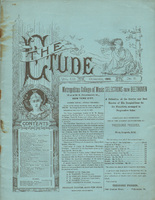“Among all known musical compositions written for the piano, which is the most difficult of execution?” To this often asked question Le Figaro has endeavored to obtain a definite and final answer by interviewing the best-known pianists and teachers of the piano in Paris. The attempt has not been very successful. Some of the “virtuosi” interviewed saw in the question only an opportunity to say something clever and epigrammatic, and made no attempt to really answer it. Others wandered from thepoint (sic) by confusing execution with interpretation. Those who rightly understood the question as referring solely to mechanical difficulties and treated it seriously in their replies were so far apart in their views that the discussion was practically unresultant, and left the question but little nearer settlement. The palm of difficulty was not definitely awarded, but there was so much in the discussion that will probably be of interest to students of piano music that it has seemed worthy of review.
No fewer than sixteen compositions and groups of compositions are named by the French pianists as among those presenting the greatest technical difficulties to the performer. They are as follows: Beethoven’s sonata, opera 57 and 106; Bach’s “Chromatic Fantasy and Fugue,” Brahm’s “Variations on a Theme of Paganini,” Balackireff’s “Islamey,” Chopin’s “Ballades,”
first, third, and fourth, and the finale of his sonata in B flat minor; Liszt’s “Études” and twelfth “Rhapsody,” Schumann’s sonata in F-sharp minor, and his “Études Symphoniques,” St.-Saëns’s “Allegro Appassionata,” a sonata by Thalberg, and a sonata by Von Weber. Of these compositions only four have more than one vote, and none has more than two. Only one composition has the undivided support of its adherents. This is Balackireff’s “Fantasie Orientale Russe,” “Islamey,” which both Louis Diemer and Francis Plante declare to be pre-eminently the most difficult to execute of all music yet written for the piano. Mme. Roger-Miclos and Marmontel, the oldest of the Professors of the Paris Conservatoire, pronounce for Liszt’s “Rhapsodie, No. 12,” among others; Raval Pugno and Mme. Roger-Miclos name the Beethoven sonata in B flat, opus 106, and these two pianists are also agreed as to the extraordinary difficulty of Schumann’s sonata in F sharp minor.
“Islamey,” then, must be pronounced the winner in La Figaro’s competition. This composition is not yet very generally known among American pianists. Of the three other more familiar works named as peculiarly difficult, American pianists generally will be inclined to rank the Beethoven sonata “für Hammerklavier,” opus 106, as the severest test of virtuosity. The other Beethoven sonata that figures in the list of the 16 most difficult compositions, opus 57, the familiar “Sonata Appassionata,” is in the repertoire of about every professional pianist. Opus 106 is very seldom played in public. As practical proof of its difficulty it may be mentioned that Von Bulow once publicly broke down in it while playing it from memory, some years ago, at Chickering Hall. The break-down was covered up, the audience being given to understand that something had gone wrong with the instrument. The tuner in attendance was sent on the stage with instructions to spend 15 or 20 minutes in ostensibly putting the piano to rights, while Von Bulow, out of earshot of the audience, utilized the time thus gained by furiously practicing, on an upright piano, the passage that had baffled him. As for the difficulty of the Liszt “Rhapsodie,” it may be remarked that this perfect pianist, than whom no composer ever knew better the capabilities and the limitations of technic, wrote always “for the hand,” and presented no problems of execution out of the range of virtuosity. Classing one of his compositions as preeminent for technical difficulties is, therefore, rather the reverse of a compliment to this composer. The proverb in regard to those who ask questions that the wisest cannot answer may be not improperly borne in mind while considering the problems of execution that the most skilled pianist cannot fully solve, presented in musical compositions intended to be played on the piano by mortal hands.
The epigrammatic answers of some of the Parisian pianists in La Figaro’s questions, though they have next to no relevance, are sufficiently amusing and suggestive to be worth quoting. C. de Beriot holds that, since pianists are not provided, as they should be, with five thumbs on each hand, and are forced to struggle all their lives against the inequality of their fingers, as to strength and length, and especially against the weakness of the fourth finger, the technical feat that pianists find the most difficult of all is playing the simple scale, as it should be played, with absolute evenness. Delaborde’s opinion, which, paradoxical as it is, will be shared by many a timid player at the moment he takes his seat on the piano stool before his audience, is “For me the most difficult of piano pieces is whatever piece I happen to be playing while I am playing it.” Andrew Gresse believes that the composition most difficult of all to play with entire correctness is any composition that one finds himself obliged to play in the presence of its composer. Composers, much in the habit of hearing their compositions played, will probably, if they are quite frank, fully endorse M. Gresse’s view. And even the most skilled of pianists will own that sometimes, bowing himself off the stage amid storms of applause for his “perfect execution” of some monumental work of Bach, Beethoven, or Schumann, he has had much reason to rejoice in his heart that the composer could not possibly have heard his playing, being dead. “Les morts ne reclament pas!” as M. Andrew Gresse puts it.



